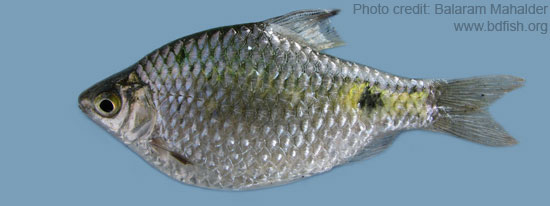
Systematic position
Phylum: Chordata
Class: Actinopterygii (Ray-finned fishes)
Order: Cypriniformes (Carps)
Superfamily: Cyprinoidea
Family: Cyprinidae (Minnows and carps)
Subfamily: Barbinae
Genus: Puntius
Species: P. terio
Synonyms
Barbus terio (Hamilton, 1822)
Cyprinus terio Hamilton, 1822
Puntius muzaffarpurensis Srivastava, Verma & Sharma, 1977
Systomus gibbosus McClelland, 1839
Systomus terio (Hamilton, 1822)
Common/local names
English: Onespot barb
Bangladesh: Teri puti (টেরি পুঁটি) and Puti (পুঁটি)
India: Teri-pungti (West Bengal) and Kakachia-kerundi (Orissa) (Talwar and Jhingran, 1991).
Distributions: Bangladesh, northern India and Pakistan (Talwar and Jhingran, 1991).
Conservation status: Not threatened in Bangladesh (IUCN Bangladesh, 2000).
Morphology: Body elongate, deep and laterally compressed. Body depth 2.4 times in SL, head length 3.3-3.8 times in SL (Talwar and Jhingran, 1991). No barbels. Lateral line incomplete. 22-23 (Rahman, 1989 and 2005; Talwar and Jhingran, 1991) scales in longitudinal series.
Body color metallic green above and whitish below with a fairly weak reddish or violet lustre. Green-silvery on flanks. A large round black blotch with golden margin over anal fin. Fins are hyaline or yellowish. Dorsal fin often with numerous dark spots and streaks and often united into a longitudinal band (Talwar and Jhingran, 1991).
Fin formula: (please don’t break the following serial)
D. 11 (3/8); P1. 14-15; P2. 9; A. 8 (3/5) (Rahman, 1989 and 2005)
D iii 8; A ii 5; P i 14; V i 8 (Talwar and Jhingran, 1991)
Maximum lengths: 6.3 cm (Rahman, 1989 and 2005) and 9 cm (Talwar and Jhingran, 1991).
Habitats: Inhibits rivers, ponds, ditches and inundated fields throughout Bangladesh, especially during May to October (Rahman, 1989 and 2005).
Sexing: Male is yellowish all over, its anal and pelvic fins are touched with orange; the female is silvery with clear fins (Talwar and Jhingran, 1991). The male becomes a beautiful orange at mating time, the females are more robust when mature (Talwar and Jhingran, 1991).
Spawning: Spawns readily in aquarium (Talwar and Jhingran, 1991).
Fishery info: Used as food fish in Bangladesh. Also important as aquarium fish, suitable for community tank (Talwar and Jhingran, 1991).
__________________________________________________________
REFERENCES
Hamilton F (1822) An account of the fishes found in the river Ganges and its branches. Edinburgh & London. An account of the fishes found in the river Ganges and its branches.: i-vii + 1-405, Pls. 1-39.
IUCN Bangladesh (2000) Red book of threatened fishes of Bangladesh, IUCN- The world conservation union. xii+116 pp.
Rahman AKA (1989) Freshwater Fishes of Bangladesh, 1st edition, Zoological Society of Bangladesh, Department of Zoology, University of Dhaka, Dhaka-1000, p. 134.
Rahman AKA (2005) Freshwater Fishes of Bangladesh, 2nd edition, Zoological Society of Bangladesh, Department of Zoology, University of Dhaka, Dhaka-1000, p. 153.
Talwar PK and Jhingran AG (1991) Inland Fishes of India and Adjacent Countries, Vol. ??, Oxford & IBH Publishing Co. Pvt. Ltd. New Delhi-Calcutta, pp. 290-291.
Visited 1,702 times, 1 visits today | Have any fisheries relevant question?
